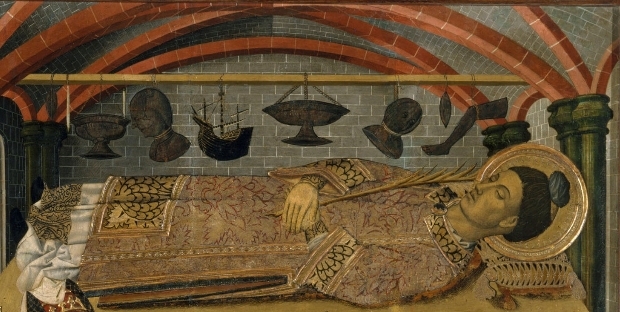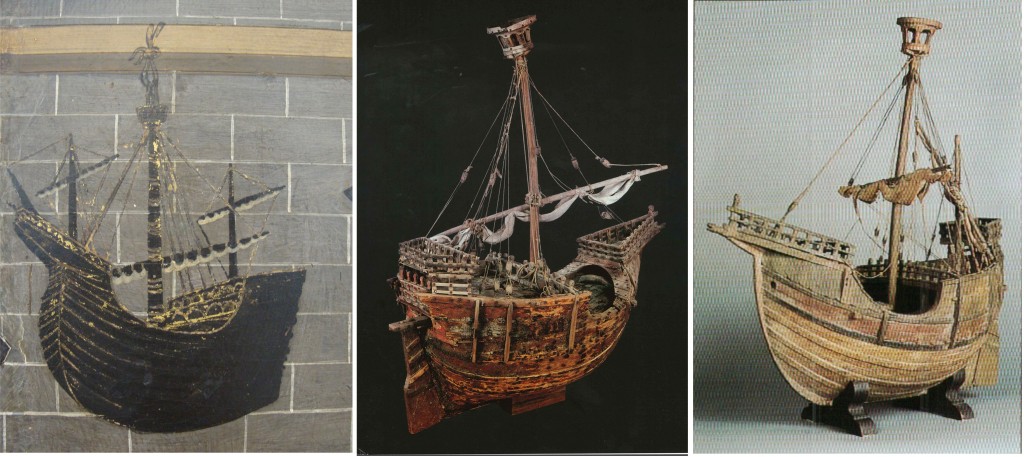The use of incisions by the artist
As we saw in the previous post, once the panel had been prepared with the different layers of plaster, the artist made the preparatory sketch. He began with sticks of charcoal and, when it was done, he half erased it with a feather; he then went over the entire drawing with the paintbrush. After that he marked the lines of the general composition with incisions and outlined the areas where he was going to place metal sheets to separate them from the ones he would paint. Following the habitual practice that the treatises of the period tell us about, the artist also used incisions, with a free, agile line, to draw and outline small details that he would later either rectify or not when applying the colour pigment. It is illustrated here for you with a few examples.
The painter moved the stone on Saint Stephen’s head to a different place
Saint Stephen is holding the palm branch in his hands and there is a stone on his head, both symbols of his martyrdom. The incisions that outline the head and the stone are done freehand, with a fluent line, while the halo has been drawn with a pair of compasses and has been embellished with a double stucco outline in relief, gilded with gold leaf and decorated with punching. Later, when the artist paints this area, he does not use the initial drawing as a guide; rather he rectifies the position and the size of the stone. In fact, he eventually painted the stone in the part that corresponded to the saint’s tonsure.
The Devil
Of the many incised lines that form the mouldings of the sarcophagus and which surround the figure of the Devil when he comes out of Eudoxia’s mouth, we only find one of them that goes through it, that of the head. Is it a mistake, or is it part of the artist’s execution technique? This fact actually shows us what we mentioned at the beginning: the painter works from a preliminary sketch and then finishes the composition with the incisions that he uses to outline the composition.
The ex-votos or votive offerings
A wooden bar appears at the top of the panel from which ten ex-votos hang in a row. In the Catholic religion, an ex-voto is an object that is offered in gratitude for divine intervention, for a cure or having obtained a result in a difficult enterprise and which, in this case, is offered to Saint Stephen in fulfilment of a vow.
The bar from where the ex-votos hang and a series of horizontal lines that depict the ashlars of the wall are incised lines done with the ruler that, as with the case of the devil, never pass over the ex-votos, which where already drawn.
Of the ten ex-votos, seven have been drawn with incisions that mark the edges and in some cases outline small details. Why are only seven drawn with an incision? Because metal sheets have been used to do them, with the desire to imitate the ex-votos that were often metal objects, and it was necessary to separate these parts from the painted ones. One of them has been analysed, the almond-shaped one, on the right-hand side of the panel, and silver has been identified in it. It can thus be extrapolated that silver metal sheets were also used in the rest of the ex-votos with the same characteristics. On the other hand, in the three other ones, which are painted, there are no incisions outlining them. It was not necessary.
In the following images we can see that the incision lines that mark the rows of ashlars of the wall end according to the curvature of the painted arches and at no time pass through the ex-votos.
In the three ex-votos that the artist painted the black ship with white furled sails is outstanding. Once it had been coloured, the gilt touches that we see today were drawn on it with the paintbrush, with water and agglutinant (glue), and powdered gold (ground fine gold).
There is a link between our ex-voto in the form of a ship and the Coca de Mataró, of which the sketch and a wooden model are conserved. They are 15th-century depictions of a type of merchant ship, a cog, typical of the Middle Ages.
Was the Mataró Cog an ex-voto too? Although it has been impossible to demonstrate, it is considered one of the oldest seafaring ex-votos in Europe. How many masts must it have had originally? The cog in the Granollers panel has three masts: fore, main and mizzen. On the contrary, the one from Mataró must have undergone changes over the years because it only has one.
Related links
Preparaciones, dorado y policromía de los retablos en madera, Ana Carrassón, Instituto del Patrimonio Histórico Español (pdf)
The Materials and Techniques of Medieval Painting, Daniel Thompson, Nova York, 1956
Restauració i Conservació Preventiva















